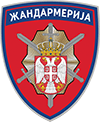 Ministry of Internal Affairs | special unit
Ministry of Internal Affairs | special unit
Updated: MARCH 14, 2024
| | Quiz
/ History and Purpose / Organization / Tradition /
Training / Gear / Cooperation /
GENDARMERIE OF THE REPUBLIC OF SERBIA
Tweet
A breaching demonstration. : specijalne-jedinice.com
HISTORY AND PURPOSE
With the end of the armed conflicts in Kosovo and Metohija, the then policymakers reckoned that the Special Police Units (SPUs), due to their impermanent operating personnel, were not able to effectively execute the given tasks. The Special Police Units, organized into six brigades, starting from January 3, 1997, continued the tradition of the Special Militia Units, established in 1972. During 1997, the Operational-searching Groups — OSGs (Srb. Operativno-potražne grupe) were established within the SPUs, which were, due to a more advanced training and better equipment of the operators, tasked to carry out specific tasks on Kosmet. Goran Radosavljević Guri carried out the commanding duties at the OSGs. Exceptional endeavors, effort and dedication during the armed conflicts in Kosovo and Metohija have built a great reputation of the Special Police Units operators. But, even with broad combat experience, these brigades had not been meeting the criteria of operability and efficiency, primarily because the then police officers had been assigning to the SPUs from their regular tasks and jobs, when needed.
With Faith in God, for the Holy Cross and Mother Serbia!
This circumstance precisely represented the main reason to, after the SPUs had been disbanded, establish the professional Gendarmerie unit in June 2001, which purpose primarily related to fighting terrorism, suppression of disrupted public order and peace, and its restoration when disrupted to a higher volume and/or area. Also, it was deemed for the unit to be of a military-police type, organized according to territorial criteria, which should have, with special training and equipment, been a prerequisite of a high operability and reliability of the unit on the territory of the then country. With the efforts from the then Minister of Internal Affairs, Dušan Mihajlović, Chief of the Public Security Service Sreten Lukić and, at the time, Police Colonel Goran Radosavljević Guri, the necessary preparations to stablish the modern Gendarmerie have been completed. Colonel Radosavljević was the first commander of the modern Gendarmerie, from June 21 2001 to August 17 2004, when commanding duties were ceded to Borivoje Tešić. In June 2008, the commanding duties were handed to Srđan Grekulović, and a year later, Bratislav Dikić was appointed to his position. At the beginning of August 2013, the commanding duties were ceded to Police Colonel Milenko Božović, who was succeeded by Colonel Goran Dragović in March 2015, who had previously been commanding the Counter Terrorist Unit (CTU). At the beginning of August 2018, Police Colonel[1] Dejan Luković was appointed to the commanding position, the commander of the Gendarmerie Detachment of the city of Kraljevo until that moment. In September 2023, Commander Luković was succeeded by Police Colonel Saša Kosović.
Adopting the name of the new unit, a glorious tradition of the Serbian warriors has been continued, starting from the year of 1860, when the first Gendarmerie company was established in Belgrade, by the decree of Prince (Srb. knez) Mihailo, tasked to protect public order and peace in Belgrade. The first company had 120 footmen and 15 cavalrymen in strength. The loyalty to their country and people, as well as numerous deeds of the generations of the Serbian gendarmes have built an honourable reputation of the unit, being continued to the present day.
The purpose of the modern Gendarmerie has been defined with the foundation documents, according to the meticulous analysis of the then security threats in the state, as well as the capacities of the national security system. During the operability period, the purpose of Gendarmerie has not been changing to a bigger extent, but several smaller reforms can be noted until the present day, according to the ongoing requirements on the field, along with the operating capacities of the unit itself. The mentioned reforms could have been deemed as additional clarifications of the entrusted tasks, jobs and actions, as well as defining some activities as primary ones. In general, the Gendarmerie of the Republic of Serbia is intended nowadays to carry out operational-tactical tasks, jobs and actions to:
-effectively fight terrorism at both operational and tactical levels, including other forms of organized crime[2]
-protect public order and peace, or their restitution and upkeep when disrupted to a higher volume and/or broader area
-carry out other police tasks defined by the ongoing legislation of the Republic of Serbia
Bearing in mind that Gendarmerie includes several organization units, of the regular and special purpose, it should be underlined that these, usually, have more narrowly defined purposes, fitting the general purpose of the unit. So, the present Diving Unit focuses its capacities on special actions in all types of water surfaces, surroundings and means of vessels, as well as waterside land areas. On the other hand, the Gendarmerie specialist companies are specially trained and equipped to conduct the most complex jobs and tasks primarily on land, such as high-risk arrests[3], resolutions of hostage crisis by breaching into premises and all means of transportation and the like. In addition, the Gendarmerie units are also intended to provide assistance to other organizational elements of the unit, or other Ministry of Internal Affairs and/or Ministry of Defense units, when needed on the field[4].
Watch the promo video for the “Gendarmerie” soundtrack on our YouTube channel .
In accordance with the new Law on Police[5] Gendarmerie is activated by an order of a commander of a unit (or deputy), with a previous approval by Police Director (or deputy)[6]. In extraordinary circumstances, when one or more Gendarmerie units are being activated in their full capacity, the order of the commander or deputy has to be previously approved by Police Director (or deputy), and consented by Minister of Internal Affairs (or deputy). The commander`s or deputy`s proposition for activation has to include a security assessment of a specific crisis, as well as the plan of actions to be conducted. In a case of emergency, the action plan can be submitted subsequently, no later than 24 hours after the engagement.
ORGANIZATION
Analyzing forms of security threats on the territory of the then state, it had been decided to establish Gendarmerie according to the territorial criterion, so that larger, strategically important cities have operational, independent elements of the unit. The decision was made to establish operational detachments in Belgrade, Novi Sad, Kraljevo and Niš. In November 2019, the detachment from the city of Niš was given a new base, in the city of Aleksinac.
Every of the detachments had been engaging according to its area of jurisdiction, and if needed, could have provided assistance to any of the detachments. In order to optimize the every-day operating activities, every of the detachment had its own commanding element, with executives defined in detail, subordinated to the main command of the unit, settled in Belgrade. These organization attributes have been ongoing up to the present day. By filling up the vacancies defined by the first systematization, it was deemed for Gendarmerie to become a highly operational professional unit on the territory of the state, which has quickly become obvious in practice.
The first training curriculum of instructors, followed by the first generations of gendarmes, has been very demanding in both, theoretical and practical parts, in order to optimize the time span needed to capacitate the unit to effectively carry out the given activities. Thanks to the very versatile and highly trained professionals in the country, the first phase of the plan had been conducted very well, therefore creating a possibility to establish the counter terrorist platoons at the unit, as the first specialist components at every Gendarmerie detachment. The personnel have been filling up with the most prominent operators and officers. The training curriculum, as well as the gear of these platoons, were specific, according to the then requirements of the security system and the unit itself. In the upcoming period, formation strengths of the platoons have been increasing, therefore these formations have been upgraded to a company level, at every Gendarmerie detachment. Also, the training plans and programs have been adapting, along with vigorous upgrades of specialist gear and armament.
After the disbanding of the Special Operations Unit (SOU), by merging the Diving Police Department and the SOU Diving Team, the Diving Center was established under Gendarmerie, today operational as the Gendarmerie Diving Unit, with a base in Belgrade. Thanks to the superb gear and training of the operators of the then center, Gendarmerie has additionally increased its operability.
On May 7, 2003, by the decision of Minister of Internal Affairs Dušan Mihajlović, based on the suggestion from the then Gendarmerie commander Goran Radosavljević, the elite Counter Terrorist Unit (CTU) was established under Gendarmerie, tasked to carry out the most complex tasks and jobs, such as high-risk arrests, resolutions of hostage crisis and the like. During April 2007, by the decision of the Government of the Republic of Serbia, based on the suggestion from the then Minister of Internal Affairs Dragan Jočić, the CTU was separated from the Gendarmerie organization and settled as an independent organizational unit of the Police Directorate.
During 2005, the unit`s operability was increased by organizing the VIP and Facilities Protection Unit, which, in accordance with its name, focuses its capacities on close protection tasks and jobs, as well as physical-technical protection.
During 2006, the K9 groups have been established at every Gendarmerie detachment, at first consisting of 6 K9s each. Amongst the specially trained K9s, all of which assist in executions of the given tasks and jobs, the majority consists of the German Shepherd, Belgian Shepherd Malinois, Rottweiler and Labrador breeds.
With the systematization from 2011, the First Quick Reaction Detachment was established, gathering the then specialist companies of all the Gendarmerie detachments, including the Gendarmerie Diving Center. The first detachment received a separated command, answering to the Gendarmerie Command in Belgrade, while the commanding duties had been carried out by the then Police Lieutenant Colonel Vojkan Ivanović, an experienced officer, and among other things, a parachuting specialist with over 1000 jumps.
Amid 2013, minor organization changes of the unit occurred: the First Quick Reaction Detachment was disbanded and the counter terrorist units were established at every Gendarmerie detachment. With the next systematization, the First Diving Center changed its name to the Gendarmerie Diving Unit, under the Gendarmerie Command, while the four counter terrorist units continued to operate as specialist units, and later, yet again as specialist companies.
TRADITION
The insignia of the Gendarmerie of the Republic of Serbia is presented in a shape of a shield, at which center motives of sunrays outlining a minor circular shield in colours of the state flag are depicted. In the middle of the minor shield, with three crossed swords, four ocilas (firesteels) are pictured, the symbols of the Serbian statehood.
On every June 28, the Day of the Serbian Gendarmerie is being honoured, and nurturing the Serbian Orthodox tradition, the unit celebrates its slava Saint Lazar the Great Martyr of Kosovo — Vidovdan. The Serbian medieval nobleman, Lazar Hrebeljanović (around 1329-1389) was a very prominent figure in Serbian history. With the title of prince (Srb. knez), he led the Serbian Army in the Battle of Kosovo on Vidovdan on June 28, 1389, against the army of Turkish Sultan Murat. The Serbian Prince laid down his life in these events, and was canonized postmortem. The tradition of the Battle of Kosovo is a very important part of Serbian folklore, as well as Gendarmerie`s tradition.
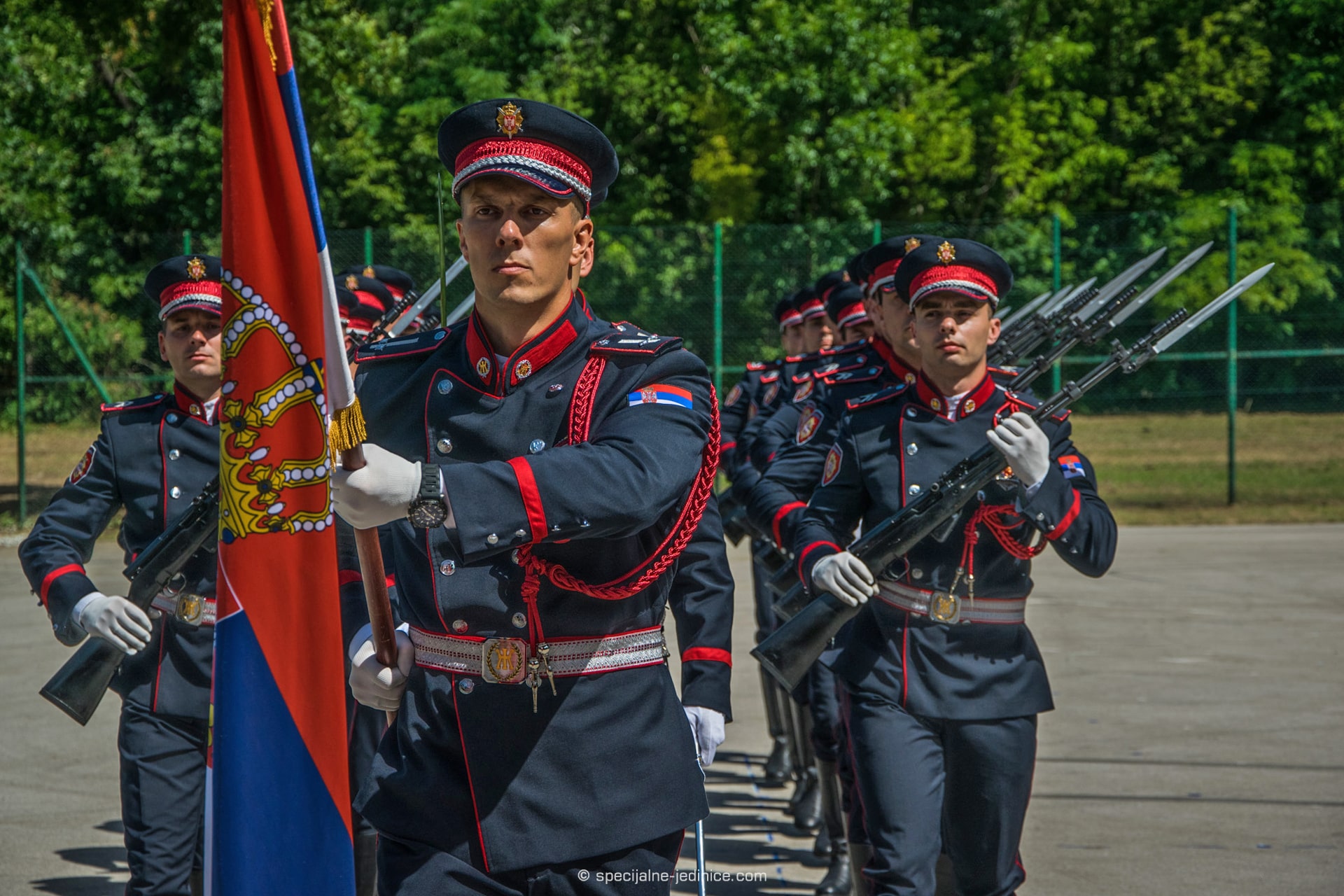
The operators of the Gendarmerie Belgrade Detachment Intervention Company, performing egzercir. : specijalne-jedinice.com
In accordance with the possibilities, the celebration of the Day and slava of the unit is being organized at all the units of Gendarmerie. Serbian religious customs are being performed on the occasion, along with tactical exercises being carried out, in the presence of church dignitaries, state officials, officers and operators of the unit, as well as friends from the country, region and abroad. The celebrations are an opportunity to mention the long tradition and achievements of the Serbian Gendarmerie, such as the events from June 15 to 17, 1862, when many Serbian gendarmes laid down their lives in clashes with Turkish soldiers at the Čukur fountain plateau and during the bombardment of Belgrade, that occurred back then. Also, the lives and deeds of the modern Gendarmerie operators, who laid down their lives in the line of duty, are being kept from oblivion. At the same time, the accomplished deeds of the active operators are celebrated, with the most prominent ones being awarded with appropriate rewards and letters of thanks.
TRAINING
Activity plan and program regarding selection and training of candidates, as well as operators, are being defined according to requirements and purpose of a specific unit, while the previous depends on requirements of a national security system within which a unit is operational. In order to effectively carry out the given tasks, the Gendarmerie of the Republic of Serbia conducts training of its operators in both, rural and urban land environments, while the Diving Unit conducts its activities primarily in water surroundings, as well as immediate land area. During the operability of the modern Gendarmerie, thanks to the professional development of the operators and officers, as well as the efforts of the Gendarmerie Command and Ministry of Internal Affairs, the activity plan and program has grown more complex, often through implementations of various experience and methods, along with mastering the ongoing ones.
Watch the training demonstration of specialists from the all four detachments during tactical demonstration in Novi Sad our YouTube channel .
With the unit`s establishment, interested police officers, and civilians as well, could have applied for a vacancy at the modern Gendarmerie, at first. The candidates had to meet standards during psycho-physical checks, as well as during meticulous background checks, in order to be eligible for a selection training, which lasted for three weeks at first, and has been carried out at training centers in the country. The training curriculum has been carried out and modeled on the foreign units of similar purpose, according to the local experience, and the requirements of the unit itself, as well as the then national security system. The drill has been constructed to deter those of weaker character to operate in a unit of this type. Therefore, candidates would have constantly been exposed to psycho-physical hardships and checks of various types. Simultaneously, the drill flow has been aimed to develop a sense of belonging to the unit, as well as togetherness and teamwork amongst the candidates, and operators of the unit, later on. Quitting on selection has been set as voluntary, being a practice to the present day[7].
Watch the training demonstration of the Aleksinac Detachment specialists on our YouTube channel .
After the selection and assignment of the first gendarmes to the detachments of the unit, a prerequisite for picking the most prominent operators and their further professional development has been achieved. The management of the unit, with the approval from the ministry, has decided to establish a counter terrorist platoon at every detachment in the country, representing, at the same time, the cornerstone of the Gendarmerie specialist component. The activities of the then counter terrorist units have been conducted in rural surroundings most often, focusing on the study and practice of special operations tactics in small tactical formations. Topography has been studied meticulously, with elements of survival training in all conditions, tactical movement in a pair, group, tactics of reconnaissance, ambush, surrounding and destroying the enemy positions and the like.
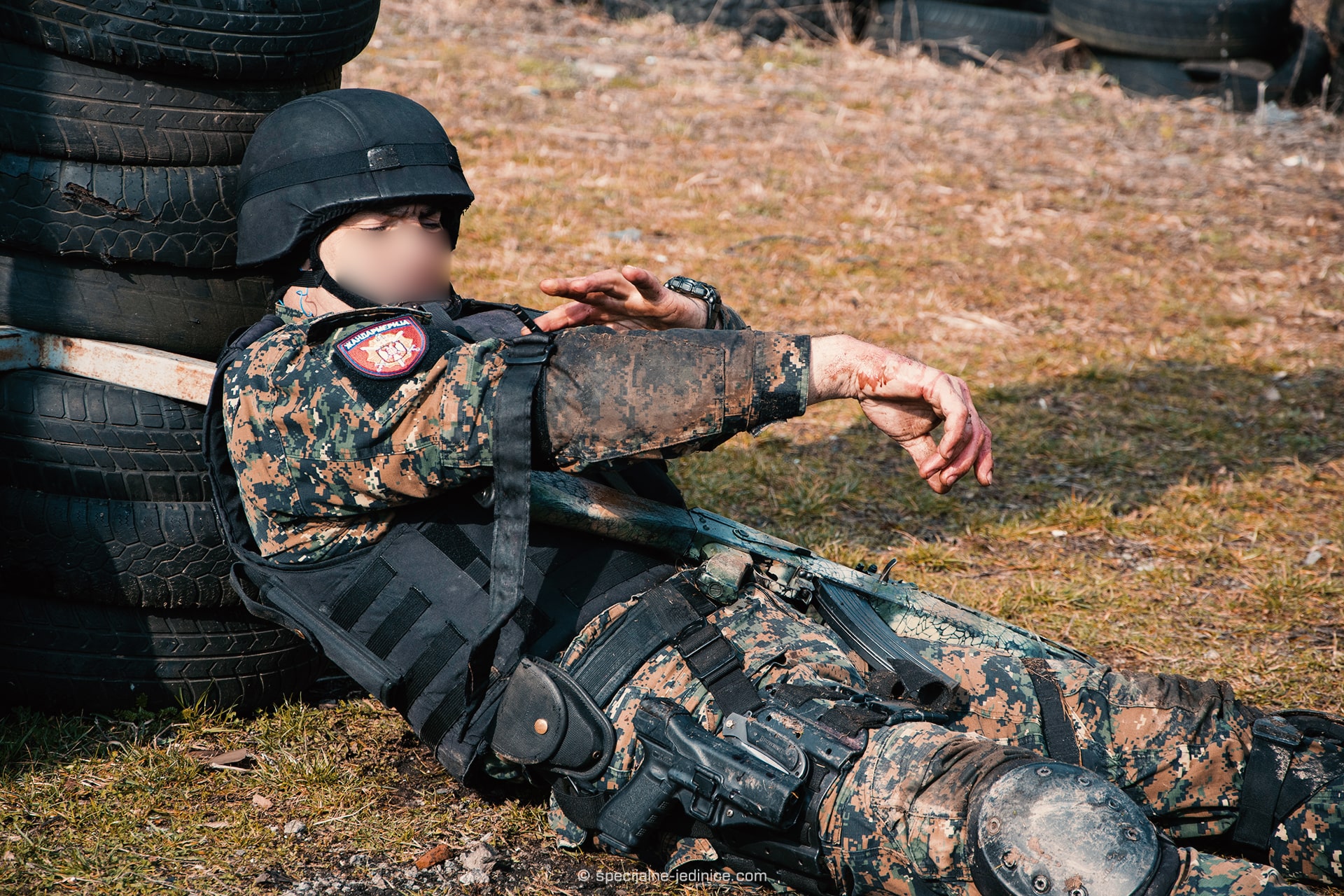
A detail from specialist training — tourniquet use. : specijalne-jedinice.com
Today, within the training curriculum of the Gendarmerie operators, there is a difference between the curriculum intended for the operators of the regular units, and the curriculum intended for the specialist units` operators. Operating personnel of the Ministry of Interior, with at least two years of service as an authorized official (Srb. ovlašćeno službeno lice) , are eligible to apply for a vacancy at the Serbian Gendarmerie. A more often practice of public job openings is being noticed lately, meaning those are open for the interested civilians. The operating personnel of the Gendarmerie specialist units are, as a rule, ranked up with the best Gendarmerie candidates.
When applying, the interested candidates from the Ministry of Internal Affairs organizational units submit documents confirming their identity, employment at the ministry with the status of an authorized official (AO), confirmation of no criminal record (being set extensively, meaning that both, criminal conviction and involvement in criminal proceedings must not include the candidate, nor the members of their immediate family) and the like.
Security checks of every candidates, as a rule, are conducted by the security and legality officers. Those who meet the security criteria, including the later psycho-physical checks, are called up for a selection training, being carried out at centers in the country, such as those in Mitrovo Polje, Village of Petrovo, Goč Mountain and others. During the selection, the candidates are being exposed to maximal psycho-physical efforts, aimed to test their will and motivation to become a part of the Serbian Gendarmerie force. Faced with the maximal work, minimal rest and lack of comfort, many of the candidates decide to quit. Health of the candidates is being monitored by a group of doctors, who are empowered to suggest instructors to remove those candidates evaluated with seriously endangered health, for some reason. The methods used by the instructors are not pleasant at all, but do not insult human dignity in any manner, nor personality of a candidate, which is the standard without exception. The unit needs the most prominent and capable individuals, therefore, the individual results of every candidate are being monitored, along with personal traits expressed during the stressful situations and order execution, as well as their sense for teamwork and effort in a group. The daily activities include strength exercises, such as squats, pushups, crunches etc., various tasks on the field and elements of basic infantry training. The candidates study use of gear and weaponry being held at Gendarmerie, while every candidate holds the Zastava M70 AB1, or AB2 rifle, chambered in 7.62×39 mm, and the semi-auto CZ 99 9 mm handgun, along with other elements of their personal loadout, such as a camo uniform or an overall, tactical vest, ballistic helmet etc. Most of the time during the selection the candidates spend using this gear precisely. At the end of the selection training, the results of every candidate are being summarized, and the instructor team decides whether or not one meets the standards of the unit. In case of a positive decision, a candidate is being given an employment contract at the Serbian Gendarmerie, therefore, the new operator continues with professional development to execute the given tasks and jobs at some of the Gendarmerie detachments[8]. The new operators intensively improve their fitness in this period, while physical training includes self-defense techniques, techniques used when attaining control over a suspect and arresting, as well as actions of overcoming different obstacles. Besides, the new operators study and practice the actions of use, handling and firearm maintenance[9], being used at the unit, and other gear or vehicles being at the unit`s disposal. Theoretical lectures include several fields, such as firearms, legislation, with a special attention on the official executives, means of coercion, conditions and methods of their legal application etc. A very important field regards to the study of tactics being applied when conducting service activities. Within tactical training, the study of various actions, commonly, starts with theoretical lectures, followed by the practice of the easiest actions and procedures, preceding the more complex ones.
Watch the tactical demonstration of the Novi Sad Detachment specialists at the “Kula” Training Center on our YouTube channel .
The ranks of the specialist units are, commonly, filled up by selecting candidates from the regular Gendarmerie units. Gendarmes with exceptional professional achievements apply voluntarily. The selection for a vacancy at the elite units is similar to the one carried out for the regular Gendarmerie vacancies, but with standards being higher, because a certain level of previous knowledge and skills is expected. Expecting the professional training of a certain level, the instructors impose very complex tasks and jobs on these candidates, and expose them to extreme efforts. Their reactions in stressful situations created by the instructors are put in the spotlight, while the candidates are expected to express those virtues that would be prerequisites for a proper and effective respond in real engagements. Therefore, various methods have been created, checking courage, determination, the ability to take action, emotion control and the like. At the same time, the level of firearms training of the candidates applied is put on a test, along with their tactical comprehension. The candidates are tasked with complex tactical situations in shooting ranges and field, requiring several methods and broad knowledge for a successful completion, individually as well as in pairs, groups and teams. Within shooting and firearm training, gendarmes familiarize with specialist gear and weaponry, such as the Colt M4 A4 Commando carbines, which were the main primary 5.56 mm weapon in use at the specialist companies, and the training of special operations tactics is vigorously carried out, with practical applications and checks in day and night environment, urban and rural areas. The assignment of the new personnel to the specialist units is being carried out according to the same modus operandi as during admission to Gendarmerie.
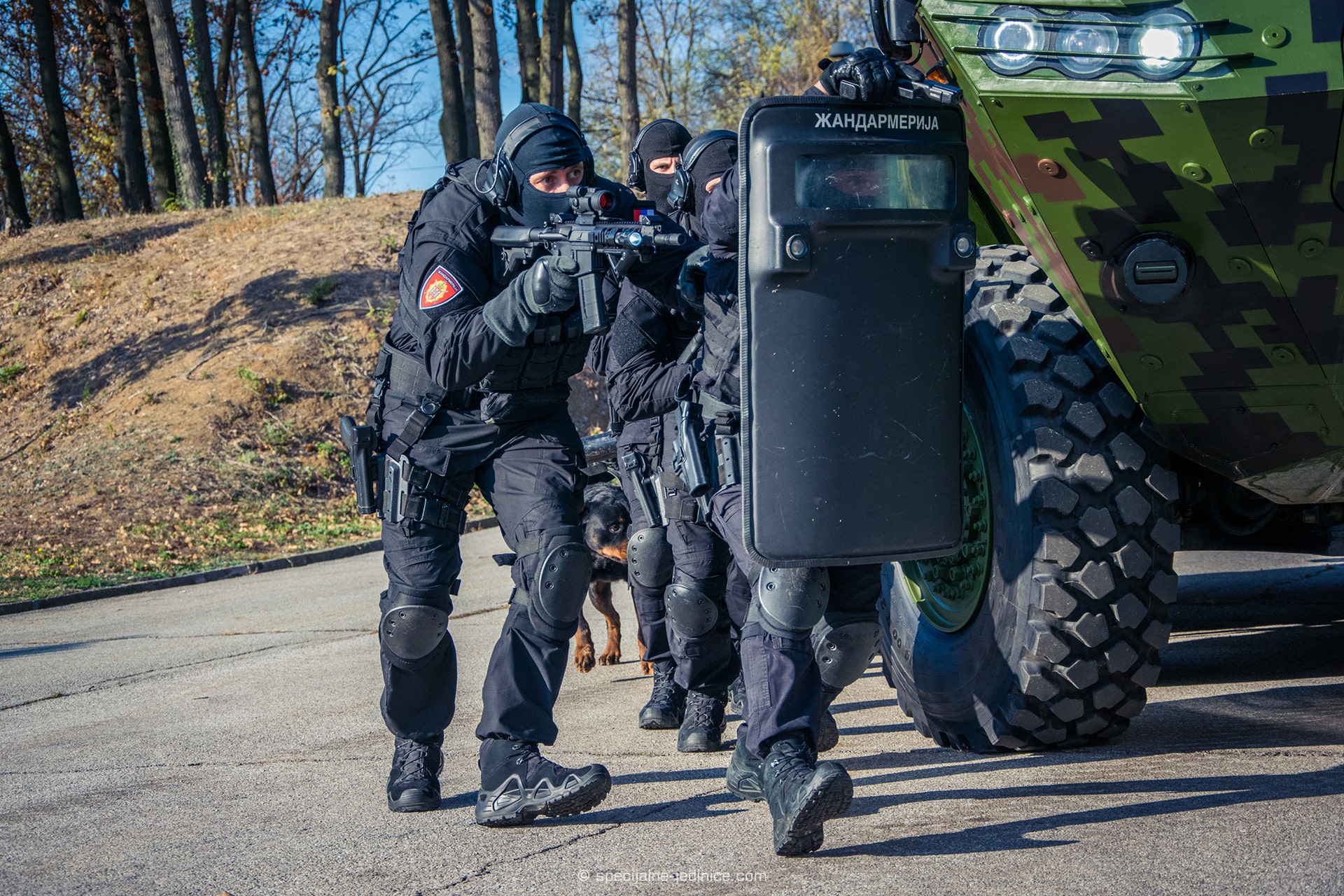
A training detail. : specijalne-jedinice.com
With their assignment, gendarmes at the elite units intensively work on improving their professional training. Special physical training here includes a more intensive study of martial arts, such as judo, krav maga, aikido, boxing and others. In addition, work is being invested into developing physical strength and VO2 max of every operator, therefore, the every-day physical training is a mandatory working activity. Moreover, climbing training is mandatory for all the operators of the specialist companies and is being carried out in urban and rural conditions. Significance of the climbing training is not only in improving the operators` operability, but in hardening their character as well, above all — self-confidence, courage and determination. Thanks to the efforts of the management of the unit and Ministry of Internal Affairs, a part of the operators` training is being conducted in cooperation with foreign instructors and the unit nurtures good relations with the Israeli instructors.
Those operators who achieve significant results, as well as interests in certain fields of training can be, according to the possibilities and requirements, dispatched to specialist courses in the country and abroad, in order to attain the specialist ranks. Thus, the specialist companies have sniping specialists, EOD specialists, K9 handlers and others, in their ranks. A basic parachuting curriculum had been created in the previous periods, but has never been conducted. Nevertheless, the units have operators with parachuting ranks, attained privately, or within other organizational units.
The Ministry of Internal Affairs Training Center “Kula”, in the homonymous town, is very important for the training of gendarmes. Thanks to the superb assets of the center, operators are able to study and practice urban climbing training, whilst shooting training and advanced tactical training are being carried out at shooting ranges of various types. The capacities of the center allow the practice of special operations.
GEAR
The weaponry and gear in use at the Gendarmerie units is adapted to the needs of the intended tasks and jobs. Models from domestic and foreign manufacturers are in use, with a noticeable tendency for national arms industry models to be present in each category of infantry armament and gear. Procurements are being completed by the decision of the Command and in cooperation with the management of Ministry of Internal Affairs, according to the requirements of the unit and funds available. Bearing in mind that execution of the most complex tasks given, as a rule, is entrusted to the Gendarmerie specialist units, a special attention is given to their proper gearing up, while smaller personnel in strength at these units allowed procurements of some high-end contingents of foreign gear.
In the semi-auto handguns category, the main models in use are CZ 99 in 9 mm, produced by the national Zastava Arms manufacturer. The units also have models of the CZ 999 series at disposal, in the same caliber, from the same producer. The Austrian Glock 17s 9 mm Parabellum, of the second, third and fourth generation, have been purchased for the requirements of the specialist units, with the Gen 3 models being the most numerous ones and the Gen 4 models delivered during 2019. The compact CZ P10 C in the same caliber have been introduced as well, for which the Horned Viper holster manufacturer has made excellent kydex tactical holsters. The units hold certain contingents of the Swiss SIG Sauer P220 9 mm Parabellum, and for the training requirements the Amadeo Rosi, Smith & Wesson, Zastava Arms revolvers and others are being used. The operators have holsters delivered by Mile Dragić for the needs of drop-leg carry, while the operators of the elite Gendarmerie units use the BLACKHAWK! SERPA Tactical Level 2 and Level 3 holsters, in black. Bearing in mind the personal inclinations of the operators, the officers allow certain adaptations of personal weaponry, such as various iron or reflex sights, tactical lights, foregrips and the like.
As for the submachine guns, the main models in use are HK MP5s, in various versions. The units have at disposal the A2 models, with a fixed stock, the A3 models with a telescopic one, as well as the suppressed SD3 models, along with the MP5 K shortened ones, all chambered in 9×19 mm Parabellum. Various accessories have been purchased for the needs of the specialist units, used to modify the mentioned models to meet different needs on the field. Therefore, the standard Picatinny rails, delivered by UTG, can be attached onto a handguard, along with assault handgrips (foregrips) and hand pads, purchased from UTG as well. Tactical lights in use have been provided by various manufacturers, with models with white light being procured for the needs of the unit. The efficiency of use is certainly increased with reflex sights, or red-beam lasers. The Zastava M92 models are also in use, modeled on the Kalashnikov system, chambered in 7.62×39 mm, marked as submachine guns by the Zastava Arms producer. When it comes to personal defense weapons — PDW, the Zastava M84 A Scorpion 7.65×17 mm models from the national producer are in use.
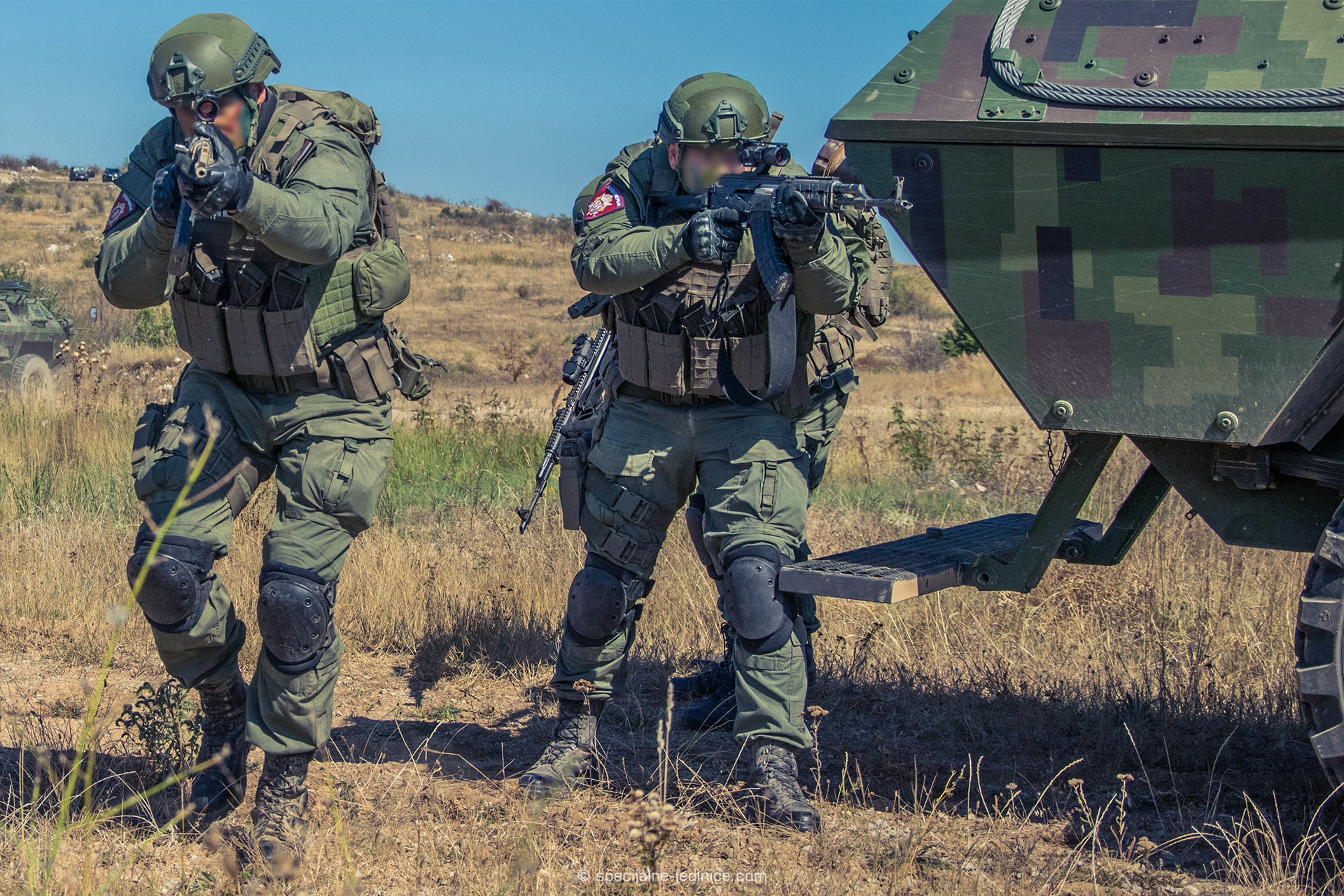
The operators armed with the Zastava M-05 E3 systems, in 7.62 mm, during training at the Pasuljanske Livade Military Range. : specijalne-jedinice.com
As for the primary armament, several systems are at disposal, mostly the Kalashnikov variations. Gendarmes have the Zastava M70 AB1 7.62×39 mm models with a fixed, and the M70 AB2 with a folding stock and more compact size, compared to the aforementioned series. The Zastava M70 AB2 systems are fitted with the standard rails from the UTG producer, attached according the 12-3-6-9 layout, commonly being used in configuration with the UTG red dot sights, assault handgrip from the same producer, or from the Israeli Tdi Arms company, and a telescopic buttstock, from UTG. The national manufacturer provides the M21 rifle series, modeled on the Kalashnikov system, but in 5.56 mm caliber. The mentioned series has been developed within the Soldier 21 project of the national arms industry, and usually models M21 S, constructed for special forces, are present at the Gendarmerie units. Capacities of the units have been increased by introducing the Zastava M05 E3 7.62 mm systems, that gendarmes use in configuration with the Holosun HS406A reflex sights. The reliable East-German AK 47s in 7.62×39 mm are in use, featuring a fixed buttstock, superb mass balance and acceptable total weight, all of which are very positive traits, when deeming a firearm tactical-combat use. The units have the 40 mm under-barrel grenade launchers at disposal, produced by Zastava Arms, modeled on the Russian systems. The Gendarmerie specialist units have significant contingents of the high-end Colt M4 A4 Commando 5.56 mm carbines. The Picatinny rails from CAA and UTG have been purchased for these systems, along with the Aimpoint CompML2 red dot sights and the CompML3 models. Moreover, all the carbines have been fitted with the CAA FGA ergonomic assault handgrips, with the CAA TC1 tactical lamps imputed, whilst the telescopic buttstock have been delivered by UTG.
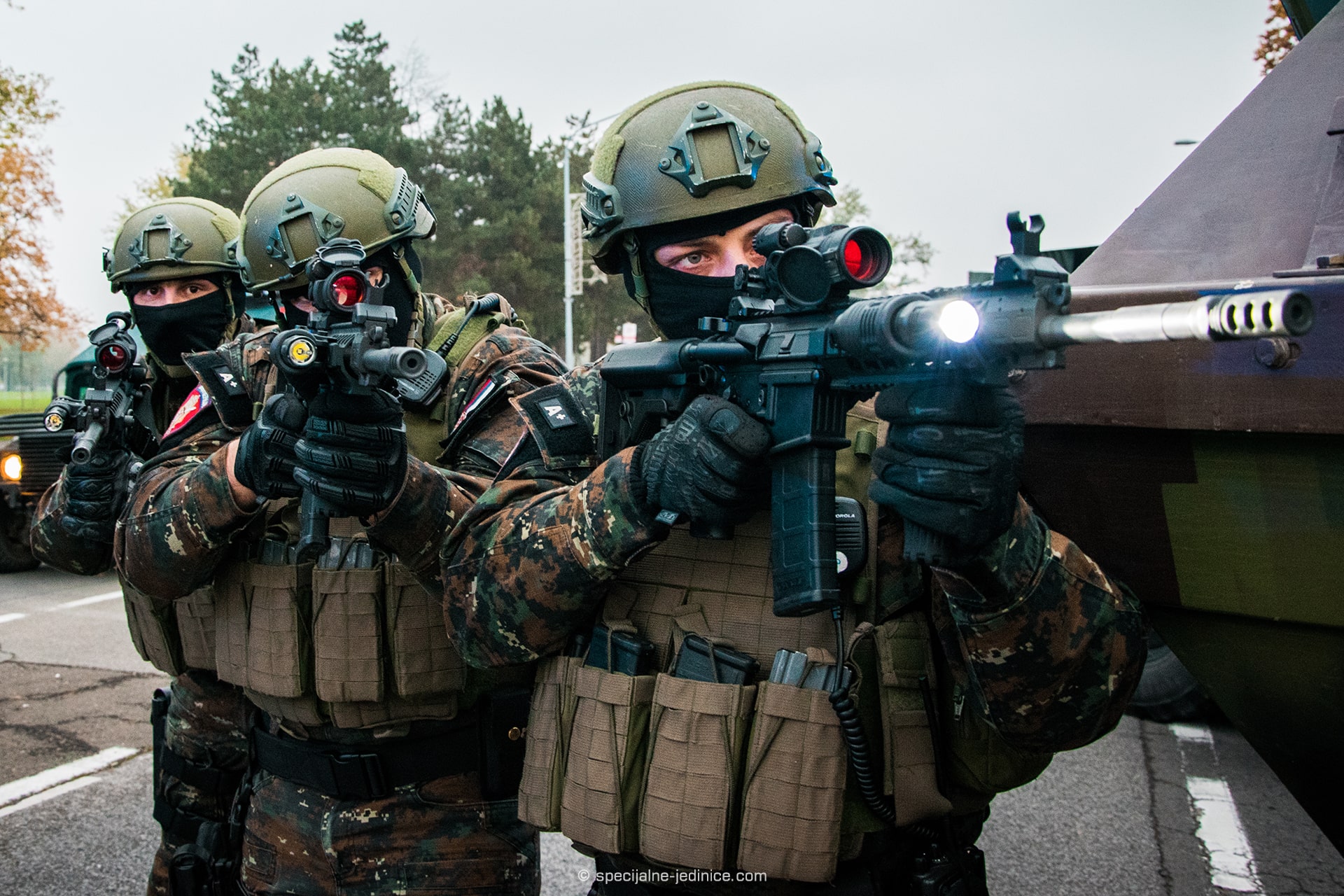
The SIG 516 systems, in 5.56×45 mm NATO. : specijalne-jedinice.com
At the end of 2018, a significant contingent of the high-quality SIG 516 CQB systems and versions with standard-length barrels was delivered, in configuration with the B5 Systems Bravo Stock telescopic stocks, Aimpoint Patrol Rifle Optic red dots and Magpul PMAG 30 AR/M4 M2 MOE Window polymer magazines. The Swiss systems are the main 5.56 mm primary of the Gendarmerie specialists, and operators often mount tactical light into the FAB PLA-1 adapters for the requirements of CQB. Tactical shotguns, produced by Zastava Arms are used for the needs of special operations/actions, especially when breaching into premises and conducting room clearing, and units hold certain contingents of the Benelli M4 A1 12-gauge shotguns, with a telescopic buttstock and iron sights with tritium fiber optic sights in green (the rear) and red (the front).
For the requirements of precision shooting, the Serbian Gendarmerie operators use the semi-auto Zastava M76 rifles in 7.92×57 mm, as well as the Zastava M91 models in 7.62×54 R, modeled on the Kalashnikov system. The Zastava M69 systems are also chambered in 7.92×57 mm. Moreover, the units have certain contingents of the HK G3 rifles at disposal, in the semi-auto A4 versions in .308 Winchester, as well as the G3 SG1 models, from the same producer in 5.56 mm. The anti-materiel Zastava M93 “Black Arrow” bolt-action 12.7×108 mm rifles are used to engage the long-range targets, targets behind cover, or the light-armored ones. The semi-auto SIG 716 rifles in 7.62×51 mm NATO have been purchased for the needs of the specialist units. In configuration with the KAHLES K-312 3-12×50 optics can be effectively used at medium distances. The Steyr Tactical Elite .308 Winchester bolt-action systems are in use, usually in configuration with the mentioned KAHLES optics, mounted onto the MAK Milmont optic mounts. The same manufacturer has delivered the superb SSG 08-A1 .338 Lapua Magnum systems, fitted with the KAHLES K624i 6-24×56 optics, as well as the SSG M1 ones, in the same caliber. Operating capacities have been additionally increased with the Accuracy AXMC .338 Lapua Magnum systems, in configuration with the amazing Schmidt & Bender Police Marksman II 5-45×56 optics. The specialist units also have contingents of the Barrett M82 A1 semi-auto anti-materiel rifles, with the Swarovski 10×42 optics, in 12.7×99 mm NATO (.50 BMG). Besides these, the bullpup Barrett M95 versions are in use, chambered in the same caliber, but with the bolt-action operating principle, fitted with the Bausch & Lomb 10×40 optics.

The specialist armed with the high-quality Steyr SSG 08-A1 system. : specijalne-jedinice.com
As for the fire support category, the Zastava M84 light machine guns in 7.62×54 R, produced by Zastava Arms, have proven as highly reliable in all weather-terrain conditions. The heavy Browning .50 BMG machine guns are in use as well, and units have the Zastava M93 30 mm automatic grenade launchers at disposal. When needed, they can be mounted onto specialized vehicles or vessels in use at the units.
When engaging or conducting training on vessels, or carrying out climbing training, the Jobe helmets can be used to protect a head against mechanical traumas. A significant part of climbing gear is being procured from PETZL, the well-known US manufacturer. Ballistic head protection is achieved with the MD 97 helmets in PASGT design. Helmet covers have been delivered by the same producer. According to the claims of the national producer, these helmets provide the IIIA level of protection, according to the NIJ STD 0106.01 Standard. The same producer manufacturers the MICH 2002 helmets, which have been delivered to the Gendarmerie units at the end of 2017, in a shade of green and in black colour, in configuration with tactical rails and a front optics shroud with helmet bungees, as well as the FAST High Cut helmets in black and in similar configuration.
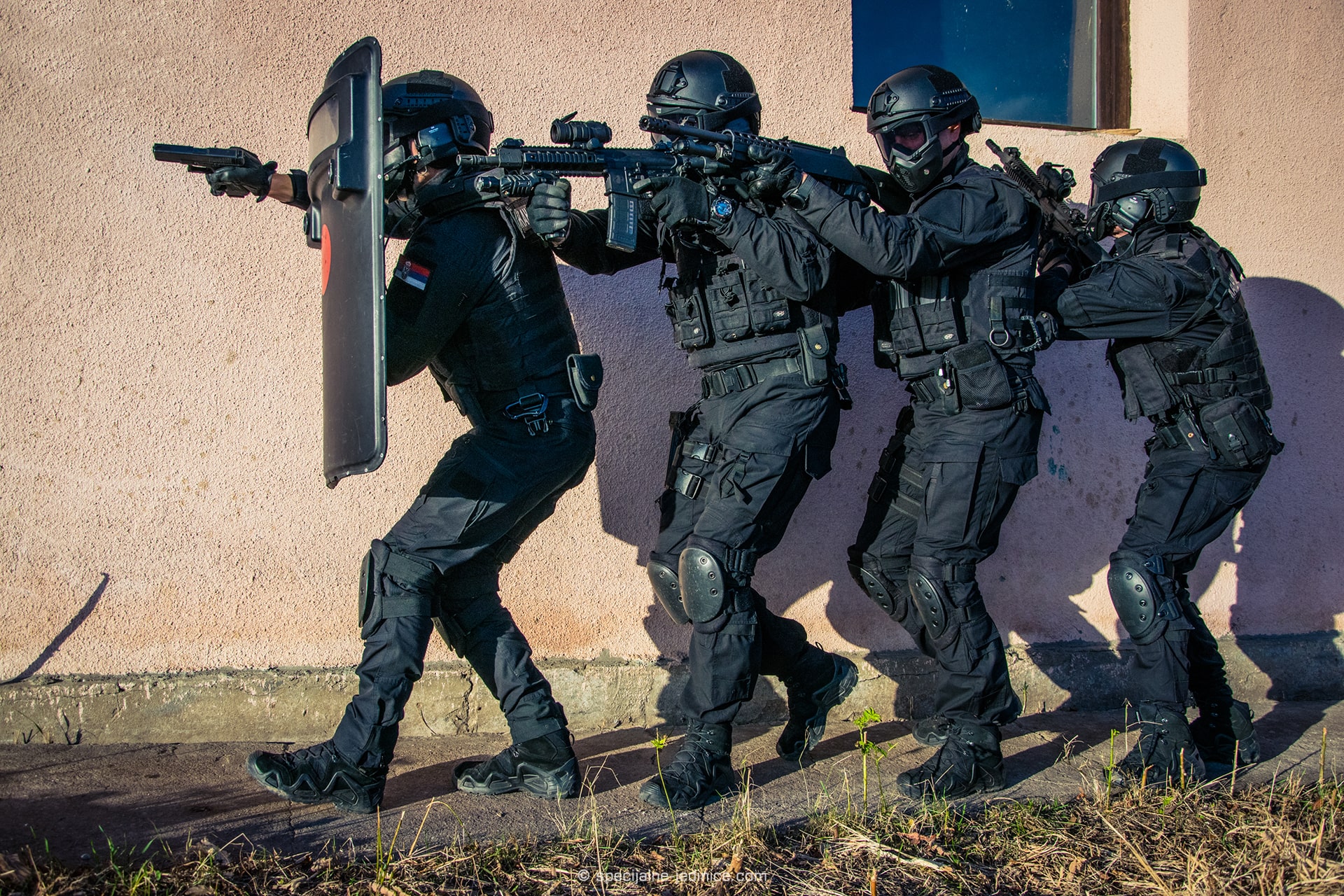
The specialists of the Aleksinac Detachment during urban special actions practice. : specijalne-jedinice.com
The CGF Gallet S.A. helmets have been procured for the requirements of the Gendarmerie specialist units in matte black, but are seldom used, due to the introduction of the new MD helmets.
The operators use several two-piece tactical uniforms and overalls for the needs of engagements. So, when conducting activities in urban area, the operators wear two-piece uniforms, produced by Mile Dragić, in urban digital camo pattern, modeled on the US AT Digital, and in the Dragon Tactical cut. When adapting to rural surroundings, the operators use two-piece uniforms of the same producer, in the same cut, but with a digital camo pattern that the producer has developed especially for the requirements of the Serbian Gendarmerie. The mentioned pattern and the US MARPAT one are visually alike. The units also hold a certain number of two-piece uniforms and overalls from the national producer, in the Woodland camo, today being used mostly for the needs of selection of candidates, seldom on the occasion of engagements. The Gendarmerie specialist units can be recognized by their black two-piece Mile Dragić Dragon Tactical uniforms, as well as the models manufactured by Yumco ad, also in black. At the end of 2017, the two-piece tactical uniforms, produced by Yumco ad, in Dragon Tactical cut and in the Ranger Green monochrome shade of green, were introduced.
The operators wear vests of various types over the uniforms, for the needs of engagements. So, when conducting the tasks and jobs regarding public order and peace, the gendarmes wear black anti-trauma protective vests, produced by Mile Dragić, while the protective loadout on the occasion consists of a helmet with a protective visor, forearm and leg protectors. Individual, as well as group protection[10] of the operators is additionally being increased with transparent light shields, made from specific composite materials. Ballistic torso protection is achieved with ballistic vests procured from Mile Dragić, in black, or camo pattern, modeled on the Woodland pattern. Thanks to the MOLLE system of webbing, various pouches and holsters can be attached onto the vests. During 2017, the SHARK body armors, in a shade of green, from the same producer, were introduced. Depending on the requirements of a specific activity, the operators use light tactical vests in black, or rural camo pattern, delivered by Mile Dragić.
Black tactical belts are being procured from Mile Dragić. Tactical belts in the green shade were delivered at the end of 2017. The 3M Peltor ComTac XP communication sets have been delivered to the specialist units, for the requirements of tactical radio comms. The specialist units also have the DTNVG-14 NVGs at disposal, delivered by ACTinBlack. Knee and elbow pads, as well as tactical gloves and goggles are being purchased from various producers, such as Mil-Tec, ESS, Revision, BLACKHAWK!, 5.11, and according to personal preferences, the operators often procure this type of gear privately.
Loadouts of the operators are being completed with the LOWA Zephyr GTX MID Task Force combat boots, in black. Tactical boots from several producers, such as Magnum, Matterhorn and others, are also being used.
The Gendarmerie units have reliable vehicles of various types at disposal. Different vans, such as Fiat Ducato, off-road jeeps, such as Land Rover Defender, road vehicles Škoda Rapid, specific quads and others, are being used for personnel and gear transport. Combat-armored vehicles M86, Lazar 2 and Lazar 3 in several configurations, products of the domestic arms industry, have been adapted to the requirements of the unit. The constructions of the Lazar 2 8×8 multi-purpose armored vehicles, produced by the national Yugoimport SDPR manufacturer, represent a combination of the MRAP and MRAV vehicle classes, with a crew capacity of 12, while the maximum road speed is 110 km/h.

Use of the multi-purpose Lazar 3 armored vehicle during a training demonstration at the Kula Training Center. : specijalne-jedinice.com
Amid 2016, the Gendarmerie units were reinforced with the new M11 and M15 4×4 combat-armored vehicles, delivered by Yugoimport SDPR. These vehicles can be effectively used when conducting combat tasks, or tasks and jobs of public order and piece protection or restitution. The crew capacity is limited to 8 members, 4 of whom are marked as permanent. The main armament of the vehicles consists of the remotely controlled weapon station with a 12.7 mm machine gun (with an effective range of 1500 m for aerial targets, and 2000 m for ground targets) and a fire-control system consisting of a TV camera with a zoom feature, thermal camera and a laser rangefinder. The maximum road speed is 100 km/h. A certain number of the light-armored HUMMER vehicles has been handed to the Gendarmerie units, after the Counter Terrorist Unit had been disbanded. Short response time in case of a crisis can be attained by using capacities of the Helicopter Unit[11].
COOPERATION
A part of the training curriculum activities of the Gendarmerie operators is being carried out in cooperation with the police and military units in Serbia, and abroad. These activities include participation in joint exercises and security seminars, providing expert assistance in training operators from countries with which the Republic of Serbia has established friendly political relations and cooperation, as well as activities conducted domestically, aided by foreign operators and/or instructors.
Within the national security system, Gendarmerie achieves a superb cooperation with all the police and military units, through joint tactical demonstrations, seminars, and joint execution of certain tasks and jobs on the field, as well. With the colleagues from the region, the Serbian gendarmes have opportunities to exchange knowledge and experience in joint international seminars, being organized annually on the territory of former Yugoslavia, while a more intensive cooperation is occuring with the Special Ant-terrorist Unit of the Ministry of Internal Affairs of the Republic of Srpska, as well as the Montenegrin elite police units.
The Gendarmerie of the Republic of Serbia nurtures excellent relations with the Israeli instructors, colleagues from Portugal, France, Romania, Algeria, Jordan, and thanks to the efforts of the policymakers, a cooperation with the Russian Spetsnaz units has been improved, along with the National Guard of the Russian Federation (Rosgvardiya).
[1] By the decision of Minister of the Interior, Colonel Luković was promoted to the rank of General of the Police in mid-2019.
[2] Most modern criminal theories deem modern terrorism to be a modality of organized crime.<
[3] High-risk arrests include crisis situations in which, based on the intel collected and processed, active resistance of a suspect or a group is anticipated, using physical force, cold weapon or firearms, or dangerous tools and the like.
[4] In the land and water areas, defined and recognized as the territory of the Republic of Serbia.
[5] Article 23, para. 4,5 and 6.
[6] The commander or deputy submit a paper on a Gendarmerie unit engagement to Police Director in the form of a proposal.
[7] It is possible, in case of serious violations of the rules and customs of behavior mandatory for candidates, or in case of health problems etc., that a candidate is removed from a selection by the decision of an instructors who carries out a specific selection training.
[8] In order to rationalize the disposal of resources, new operators are usually assigned to the detachment closest to their place of residence or stay.
[9] Special attention is given on the adoption and practical application of the safe firearms handling principles.
[10] When organizing the operators in various formations.
[11] Operators of the Gendarmerie specialist companies are trained to carry out the air insertion techniques, such as fast rope, or rappelling, as well as the tasks of aerial surveillance and air support.
The text is the copyrighted work of the editor. Copying or downloading in other way, without editor`s permission, is prohibited.
